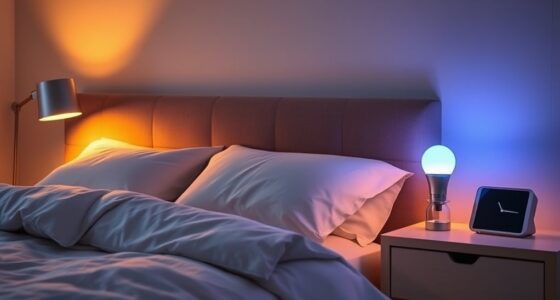To create a bedroom that suits you both, focus on customizing comfort and lighting to meet individual needs. Consider adjustable beds or mattresses with different firmness levels, and use separate lighting options like dimmers or bedside lamps. Control the room ambiance with blackout curtains or ambient lighting to foster relaxation. Communicate openly, be willing to make small adjustments, and explore solutions that balance each partner’s preferences. Keep exploring for more tips on achieving harmony in your shared space.
Key Takeaways
- Use adjustable or split beds to accommodate differing firmness and comfort preferences.
- Incorporate customizable lighting options like dimmers, smart bulbs, or blackout curtains for personalized ambiance.
- Prioritize mattress and bedding choices that balance both partners’ temperature and tactile needs.
- Maintain open communication to identify and address individual sleep environment preferences and compromises.
- Enhance sleep quality by adjusting environmental factors such as noise, temperature, and lighting for mutual comfort.

Creating a bedroom that works for both partners starts with understanding your shared needs and preferences. When it comes to designing a space that accommodates different sleep habits, a good starting point is paying close attention to your sleep environment. Your sleep environment includes everything from the mattress and pillows to the overall ambiance of the room. If one of you prefers a firm mattress while the other likes a softer one, consider investing in a split or adjustable bed that allows each person to customize their side. This way, both of you can enjoy restful sleep without compromising comfort. Additionally, think about temperature control, bedding materials, and noise levels, as these all influence your sleep quality. Creating a balanced sleep environment means addressing both partners’ needs and finding solutions that promote restful nights for everyone involved.
Lighting preferences are another key factor in designing a bedroom for couples with different sleep schedules. Some people need complete darkness to fall asleep, while others might find a bit of ambient light comforting. To accommodate these differences, consider installing adjustable lighting options, such as dimmer switches or smart bulbs, so you can customize the brightness level for each side of the room. Bedside lamps with independent controls can also be helpful, allowing one partner to read or work without disturbing the other’s sleep. Blackout curtains or shades can make a significant difference for those sensitive to light, especially if one partner tends to wake up early or go to bed later. You might also explore using sleep masks as a portable solution for individual comfort. The goal is to create a flexible lighting setup that respects each person’s preferences, helping both of you relax and fall asleep more easily. Additionally, incorporating high-quality projectors or adjustable lighting can enhance the overall ambiance and create a more personalized sleep environment.
Ultimately, designing a bedroom for couples with differing sleep preferences requires open communication and a willingness to compromise. By prioritizing your sleep environment and lighting preferences, you’re setting the stage for better rest and a more harmonious shared space. Remember, small adjustments—like adjustable lighting or a mattress tailored to individual needs—can make a big difference in your comfort and sleep quality. Keep experimenting until you find the right balance that allows both of you to get the restorative sleep you need. When each partner’s needs are acknowledged and addressed, your bedroom becomes a sanctuary that fosters restful nights and energized mornings.
Frequently Asked Questions
How Can I Reduce Noise Disturbances for My Partner’s Sleep?
To reduce noise disturbances for your partner’s sleep, you should use soundproofing techniques like adding rugs and heavy curtains, which absorb sound. Bedroom layout strategies also help—positioning your bed away from noise sources and using soundproofing panels on shared walls can make a big difference. Additionally, consider white noise machines or fans to mask disruptive sounds, creating a calmer environment for better sleep for both of you.
What Lighting Options Are Best for Couples With Different Sleep Routines?
You should opt for dimmable lighting and bedside lamps to accommodate different sleep routines. Dimmable lights let you adjust brightness easily, so your partner can relax or read without disturbing your sleep. Bedside lamps provide localized lighting, giving each of you control over your space. This flexibility helps create a harmonious environment, ensuring both of you can enjoy a comfortable sleep experience without sacrificing your preferred lighting conditions.
How Do I Balance Temperature Preferences in the Bedroom?
Balancing temperature preferences can feel like solving a Rubik’s Cube—challenging but rewarding. You should create personal temperature zones using adjustable bedding like heated blankets or cooling pads. Keep the room temperature comfortable for both, usually around 65-70°F, and encourage each person to customize their space with personal adjustments. This way, you meet both needs, ensuring restful sleep for everyone with minimal compromise.
Can Separate Bedding Improve Sleep Quality for Both Partners?
Yes, separate bedding can improve sleep quality for both partners with different preferences. It allows each person to choose their preferred warmth, comfort, and material, reducing disturbances caused by mismatched sleep habits. By using separate bedding, you can create a more personalized sleeping environment, leading to fewer wake-ups and a more restful night for both of you. This simple change can considerably enhance your overall sleep experience.
What Are the Best Storage Solutions to Minimize Clutter and Disruptions?
Think of your bedroom as a sanctuary, not a cluttered jungle. You can minimize disruptions by utilizing smart closet organization solutions that keep essentials out of sight yet accessible. Underbed storage is like a hidden treasure chest, perfect for seasonal clothes or extra linens. Combining these storage ideas helps keep your space tidy, calm, and conducive to restful sleep, so you wake up refreshed and ready for the day ahead.
Conclusion
In the end, blending boundaries and balancing bedtime beliefs bring bliss to bedrooms. By embracing individual sleep styles, creating cozy corners, and communicating clearly, you craft a space that satisfies both partners. Remember, patience and personalization pave the path to peaceful nights. So, stay flexible, stay friendly, and let your bedroom be a beautiful blend of both your worlds. With a little effort and understanding, restful nights become a rewarding reality.









